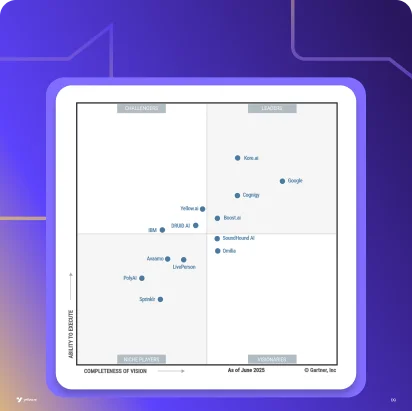Support teams deal with the same types of issues day in and day out. Things like password resets, delivery updates, or refund requests. These aren’t complicated problems, but they come in high volumes and eat up a lot of agent time.
Now, that’s changing.
According to a latest McKinsey report, up to 80 percent of these common support tickets can now be resolved without human intervention. In many cases, resolution times drop by as much as 90 percent.
That kind of shift changes how support teams operate. You’re not just reducing workload, you’re redesigning the way support works from the ground up.
In this blog, we’ll break down what’s making this possible and how Agentic AI fits into the picture.
Why Traditional Customer Support Models Can’t Scale
For today’s generation-now customers, quick and easy resolutions aren’t just nice-to-haves, they’re non-negotiable. Most of these queries fall into the category of repetitive tickets and FAQs, with little real complexity in resolving them. The real challenge isn’t in how to solve them, but in the sheer volume they come in, which leaves human support teams with less time to focus on complex, high-value issues.
Adding more agents may help briefly, but it inflates costs and doesn’t solve the root problem. This reactive setup treats each request in isolation, even when issues are identical.
The result? Staff burnout and churn become common. In fact, 75% of contact center agents report daily stress and anxiety, reflecting how unsustainable this model can become. This is where many organisations reach a ceiling. Without rethinking the design of the support process, scaling simply means multiplying the same inefficiencies.
Just as the industrial revolution transformed manual labor, and the internet reshaped how we communicate and transact, automation is now redefining how service delivery happens.
When technology evolves, the cost of staying static isn’t just inefficiency, it’s becoming irrelevant. And given the speed of today’s cycles, falling behind can happen in just 24 to 36 months.
The Stat That’s Redefining Customer Support Automation
According to McKinsey’s June 2025 findings, as much as 80% of routine customer service issues can now be handled without human involvement. In many instances, this shift has also led to a 60-90% drop in resolution time.
For years, this level of automation was seen as an ambitious target. In most enterprises, anything beyond 20 or 30 percent automation felt unrealistic. This new data shows that the ceiling has shifted. What was once a long-term goal is now within reach, with the right approach.
Today, AI automation has become a great equalizer in enterprise customer support. Access is no longer the issue. There’s no shortage of tools, platforms, or pilots. But there’s a growing gap between availability and actual impact.
It’s what many experts are terming the AI paradox: the technology is more powerful and accessible than ever, yet most enterprises struggle to see meaningful ROI.
If you want to dive deeper into how enterprises are tackling this balance between speed and complexity in customer service, check out this Envision Voices episode with Mudit, where he shares actionable strategies for scaling support without losing the human touch.
Pilot AI projects stall. Teams lose steam after initial experimentation. Leadership begins to wonder, “Are we in a hype cycle?”.
But more often than not, the problem isn’t the tech. It’s the implementation. Starting too small, choosing the wrong use case, treating AI as a bolt-on feature instead of rethinking the process altogether.
But despite the hurdles, the opportunity is massive.
McKinsey estimates that Agentic AI and Generative AI could unlock $2.6 to $4.4 trillion in additional value, beyond what’s already possible with traditional AI tools.
Agentic AI vs Chatbots: What’s the Real Difference?
Traditional chatbots follow scripts. They wait for a question, give a set response, or hand the query to an agent. They work for basic, predictable tasks, but break when conversations stray from the script.
Agentic AI works differently. It understands intent, pulls data from enterprise systems, and takes action to resolve issues, without waiting for the customer to explain every step.
As Yellow.ai’s research on conversational AI notes, chatbots often hit dead ends when tasks span systems or require context from past interactions. Agentic AI handles that complexity, moving the request from detection to resolution.
Example:
- Chatbot: “How can I help you today?”
- AI agent: “Your payment failed. We retried it, and confirmation has been sent to your email.”
Where chatbots respond, AI agents resolve, making large-scale automated support resolution possible.
This difference in capability is why enterprises using Agentic AI see such a sharp jump in efficiency. The real gains come when you stop thinking of it as a chatbot replacement and start seeing it as the driver of a redesigned support process.
Related Reads: Agentic AI in Enterprise Automation; The Future of Chatbots
Evolution of Chatbot to AI Agents
How conversational AI evolved from reactive tools to proactive, goal-driven agents
Basic Chatbots
Rule-based responses, limited to predefined flows and FAQs
NLP-Enhanced Bots
Natural language understanding, but workflow-dependent
Gen AI Bots
Dynamic conversation generation, reasoning capabilities, with human-guided task completion
Agentic AI Agents
Autonomous workflow orchestration, multi-platform connectivity, and proactive action
How Agentic AI Helps Unlock the Billion Dollar Support Market
Agentic AI enables systems to understand context, take action across connected tools, and complete a request from start to finish without handoffs. It is not an efficiency upgrade, it is a rethinking of how support can operate.
Instead of simply responding to a customer’s question, the system identifies the underlying need, gathers the required information, and resolves the issue before it escalates. This shift moves customer service from a reactive function to a proactive one, where many problems are handled before the customer even needs to ask.
When teams stop asking, “Where can I plug in AI?” and start asking, “What would this process look like if software could handle 80% of it on its own?” That’s the mindset that drives meaningful results. For enterprises, that means less pressure on support teams, shorter wait times, and a consistent omnichannel experience.
Frequently asked questions (FAQs)
What is Agentic AI in customer support?
Agentic AI refers to AI agents that go beyond answering questions, they complete support tasks end-to-end without human intervention.
How much support can be automated with Agentic AI?
According to McKinsey, up to 80% of common support incidents can be resolved autonomously, reducing resolution times by 60 to 90%.
Is Agentic AI better than chatbots?
Yes. While chatbots respond to prompts, Agentic AI proactively detects issues, triggers resolutions, and escalates only when necessary
Top 3 Reasons Agentic AI Boosts Support Efficiency by 80%
The move from chatbots to Agentic AI is more than a technology upgrade. It changes how AI customer service works, making customer support automation faster, smarter, and easier to scale. When AI agents for customer service handle full workflows instead of single tasks, the results include faster resolutions, lower costs, and better customer experiences. Here’s why.
1. Rethinking Support with AI Agents, Not Just Automating It
Many companies start by adding AI to a few tasks, like answering FAQs or summarising tickets. Agentic AI takes a bigger step, enabling automated support resolution from start to finish. It detects the issue, finds the fix, completes the process, and only involves a human if needed. This is how support ticket automation delivers real results.
2. Omnichannel AI Support, Context-Aware Actions
Customers often switch between chat, email, voice, or messaging apps. Agentic AI keeps full context across channels, so the experience is consistent. Whether in AI service desks, chatbots, or voice bots, customers never have to repeat themselves, and the process feels smooth from start to finish, powered by connected AI customer experience tools.
3. Escalate Only When It Matters
Most common support requests can be solved automatically. AI agents escalate to a human only when judgement or empathy is required. This keeps human agents focused on the most valuable cases while customer support automation handles the rest.
Yellow.ai’s Agentic AI Platform in Action
Enterprises that want to move beyond traditional chatbots need a platform capable of delivering automated support resolution at scale while integrating smoothly with existing systems. Yellow.ai’s Agentic AI platform enables AI agents to manage the resolution process end to end.
Enterprises ready to move past basic chatbots need more than just “automated replies.” They need a system that can diagnose, resolve, and close issues, seamlessly. That’s where Yellow.ai comes in, enabling AI agents to not only address customer requests but fully resolve them, all while fitting effortlessly into your existing workflows.
The mistake many organizations make? Treating AI like an add-on rather than part of how the work actually gets done. We’ve seen this first-hand: when AI isn’t connected to the heart of your operations, it doesn’t deliver real impact.
The companies getting this right don’t just buy a tool, they work with partners who help them rethink how work happens. That’s where the real difference lies: not just in technology, but in how you use it.
Why Yellow.ai
The Only Platform Which is ‘Agentic’
At All Stages of Your AI Agents’ Lifecycle


Our Key capabilities include:
- Real-time intent detection to understand customer needs
- AI agents for customer service operating across voice, chat, and messaging
- Orchestration across CRMs, AI service desks, and backend tools without handoffs
- Consistent customer support automation across all channels
These capabilities are already being applied by leading enterprises across industries to improve resolution times and deliver consistent customer experiences.
“With automation in place, employees receive their W2 in minutes vs. hours. Since going live with Yellow.ai, we’ve seen conversational AI expand across teams and use cases.”
– Jessica Osborn, Sr. Manager, IT Support Services Operations, Randstad USA
Why Enterprises Are Moving to Agentic AI for Customer Support
Customer service has entered a new phase. Users expect accurate answers instantly, on the channel of their choice, and they notice when experiences break between handoffs. Traditional models were not designed to keep up with this pace.
Industry data now shows that automated support resolution can handle the majority of common tickets while reducing resolution times by up to 90 percent. The shift is no longer about experimenting with AI, it is about operationalising it at scale.
Agentic AI is enabling that shift. By giving AI agents for customer service the ability to complete tasks across systems, keep full context, and escalate only when necessary, enterprises are building support functions that scale without adding cost in the same proportion.
The organisations moving first are seeing faster resolution times, more consistent customer experiences, and teams freed up to focus on the cases where human judgement adds the most value. Those that wait risk keeping a model that costs more, takes longer, and delivers less.
See how Yellow.ai helps enterprises automate 80%+ of support workflows. Book a demo today!






















